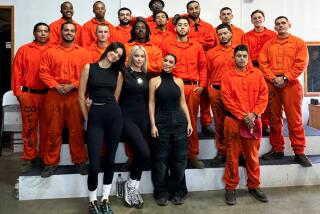Camp’s Young Cancer Patients Learn They Aren’t Alone
The rustic buildings clustered atop a hill in east Ventura County are like summer camps everywhere. Children sleep in cabins, play games, learn handicrafts, tease their counselors and giggle a lot.
When their week is over, they go back home.
But the 95 children at this summer camp are a little different. Some don’t have hair. A few lack an arm or a leg. Half are on medication. All of them have cancer, or once had it.
When their week at camp ends, some go back to chemotherapy, radiation treatments and the loneliness that comes with being different.
“This gives me a chance to be normal and do normal things” said Laura Jetton of Northridge, who has a form of bone cancer called Ewing’s sarcoma. “Here, I can be around people who understand my situation. I’m not going through this alone.”
Nearly 1,500 young cancer patients have attended Camp Good Times since the program was started in 1982 by Pepper Edmiston, a Los Angeles woman whose oldest son, David, had leukemia. She couldn’t find a summer camp that would take a boy with cancer, Edmiston said, so she started her own camp, one that would be free to young cancer patients from all over Southern California.
She had help. Her cousin’s husband, actor Dustin Hoffman, contributed money and connections. So did Edmiston’s father, Max Salter, a former mayor of Beverly Hills. Michael Jackson was an early supporter. More recently, McDonald’s became a corporate sponsor, providing 5% of the program’s annual budget of about $1 million. Its official name has become Camp Ronald McDonald for Good Times.
And there were plenty of good times last week. During a stop to drum up publicity for the program, Hoffman entertained the campers by dumping a watermelon over a counselor’s head. At lunchtime, a clown roamed the tables, taking a piece of silverware from campers who failed to stop eating when he blew his whistle.
After ignoring several whistles, Richie Hogan of Anaheim was left with no utensils and a plate still heaped with spaghetti. To the delight of the other 9-year-olds at his table, Richie plunged into the pasta face-first, looking up to display a ring of tomato sauce around his face.
Richie, who has had cancer since age 5, is used to dealing with adversity. He has had surgery and is undergoing chemotherapy for a tumor in his head.
Like Jetton and many others at the camp, Richie hides his hair loss under a hat. But many campers don’t bother.
“These kids don’t make fun of people with no hair,” said Seanne Biggs, a camp administrator. “They can take off their hats and wigs and not feel threatened. It’s a relief.”
It’s also encouraging for ill campers to see people who have been cured. That’s why former cancer patients are invited to the camp.
“It’s important for kids like Richie to see kids his age who have gone through what he has and survived,” Biggs said.
Two Ventura boys, John Sullivan and Thomas Clobes, were among the cancer survivors at last week’s camp. John, 11, has been in remission from leukemia for five years. Thomas, 12, who lost a kidney to cancer, had his last chemotherapy more than nine years ago. Both have attended several sessions of the camp over the years.
Even though Thomas is no longer sick, his mother, Shirley Clobes, said: “These kids are all in the same boat. He did lose his hair once. When he sees other kids, he feels sorry for them but can relate.”
Jetton, 18, has seen the camp from several perspectives since her first visit in 1984. That was the year a lump on her back was diagnosed as cancer. After 1 1/2 years of chemotherapy, the tumor disappeared and she was thought to be cured.
In 1987, she had a relapse, and lots of tumors. She spent 10 weeks in the hospital getting a bone marrow transplant. For a year afterward, she was free of cancer.
Then came more tumors, radiation treatments, and more chemotherapy. In spite of everything, she managed to graduate in June from West Granada High School, and she just completed a course by television through Valley College.
She said the camp has meant a lot to her, no matter the status of her disease. “All of us here, sick or well, have missed out on something,” she said. “This is our chance to do it.”
In the cabin she shares with six other 16- to 18-year-olds, the subject of cancer doesn’t come up much, Jetton said.
“If it does, it’s usually humorous things about hospitals, needles, bone marrow tests.” The prevailing attitude, she said, is “let’s leave cancer at home.”
That’s more or less the philosophy of the program, Brian Crater, the camp director, said.
Jerry Doyle, a counselor at last week’s camp, said the youngsters in his cabin sometimes talk about treatments and ask each other questions such as, “Doesn’t it hurt to get a spinal tap?”
Doyle, who lives in Oxnard, said most of the youths in his cabin don’t realize that he once had cancer too. “I don’t announce it,” said Doyle, 30, who had a brain tumor at age 21. “I don’t talk about cancer unless they bring it up.”
Each cabin has two or three counselors, all volunteers. Many are premed students or health-care workers. Doyle works at a bank in Santa Barbara. He had to use seven vacation days to work at the camp, but he said it’s worth it.
“Where else can you act like a kid and do what you want?” asked Doyle, who was working his seventh camp.
Last week’s camp was one of 14 sessions planned this year, Crater said.
Four are weeklong sessions and the rest are weekend outings.
Each camp has at least one doctor and several nurses on hand, all volunteers.
Most of the sessions are at Gindling Hilltop Camp, a rented site where last week’s camp was held.
The Gindling camp, at the southeastern tip of Ventura County, has breathtaking views of the Pacific and the Channel Islands, and it’s convenient for a field trip to the beach.
But the program is looking for a permanent home, Edmiston said.
A permanent site would save the energy spent in organizing camp sessions at various sites, and families could use it year-round as a retreat.
A few years ago, Joan Kroc, widow of McDonald’s founder Ray Kroc, was willing to provide a site near Santa Ynez in Santa Barbara County, but county supervisors, pressured by neighbors, imposed unacceptable conditions, Edmiston said.
The program has an office in Brentwood, after operating out of Edmiston’s den for several years.
Most of the camp sessions are for patients between the ages of 7 and 18, but the program also has an outing for young adults and one for the brothers and sisters of children with cancer.
Edmiston and her husband, Joseph T. Edmiston, executive director of the Santa Monica Mountains Conservancy, and their seven children regularly attend camp sessions.
David, 16, has been cured of leukemia, but at a horrible cost.
A rare reaction to chemotherapy damaged his brain.
“It’s very hard to have a perfectly normal child transformed into a profoundly retarded child,” Edmiston said.
But working on the camps gives her the kind of satisfaction felt by parents who lose a child to cancer but stay involved with the program, Edmiston said.
“It gives you sense of victory over the disease.”
More to Read
Sign up for Essential California
The most important California stories and recommendations in your inbox every morning.
You may occasionally receive promotional content from the Los Angeles Times.









